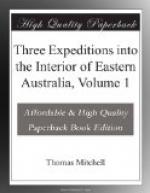The soil of the plains being extremely soft, uneven, and full of holes, the cattle were at length almost unable to get through their allotted journeys; I therefore determined to let them rest during the three following days while I proceeded to the hills beyond the Darling, in a west-north-west direction nearly, and distant from our camp 11 2/3 miles.
VISIT A HILL BEYOND THE DARLING.
June 26.
I forded the Darling where the bottom was a hard clay; and I proceeded in a direction bearing 27 degrees north of west to the hill. There was much less of the soft soil on this bank, and at a mile from the ford we travelled on very firm clay, quite clear of vegetation, white, shining, and level as ice. At about seven miles from the river we reached the first rise of firm red earth. The vegetation upon it consisted of the two species of atriplex so very common on that soil, and more of the salsolae than I had before seen. This rise seemed to mark the extent of the bed of clay through which the Darling flows, at least as far as we had hitherto traced it. The country was open to about three miles from the summit where we passed through a scrub of stunted casuarinae, interspersed with a few of the acacia with spotted bark. Here we crossed some beds of conglomerate, consisting of grains and pebbles of quartz, cemented by a hard ferruginous matrix, probably decomposed felspar; and we saw soon after a few blocks of the same hard sandstone which occurs at Dunlop’s range and other high points.
VIEW FROM ITS SUMMIT.
The summit, consisting of the same rock, was very broad and strewed with small stones, and partly covered with a dwarf acacia bush which gave a uniform tinge, like heath, to the whole country as far as my view extended to the westward. The horizon to the west and south-west was finely broken by hills resembling Oxley’s Tableland and D’Urban’s group, but the day was hazy, and I looked in vain for any indication of water. The heights towards the south-west appeared too detached also to promise any; more resembling islands in a sea, or pinnacles, only half-emerged from a deluge, so level was the general surface. Towards the north-west however the heights did seem connected, and had the appearance of being the loftier summits of very distant ranges; especially an eminence bearing 21 degrees north of west which I named Mount Lyell. There was also an isolated and remarkable summit which bore 50 1/2 degrees north of west, to which I gave the name of my friend, Dr. Daubeny. The lower ground seemed to undulate, but no part of it was intersected by open plains or any lines of large river trees indicating the permanent existence of water. On the contrary, as far as I could judge from colour and outline, the same thick dwarf scrub appeared to be the universal covering of the land; neither could I distinguish any smoke or other trace of human inhabitants, nor even the track of a single emu or kangaroo in that trans-Darling




